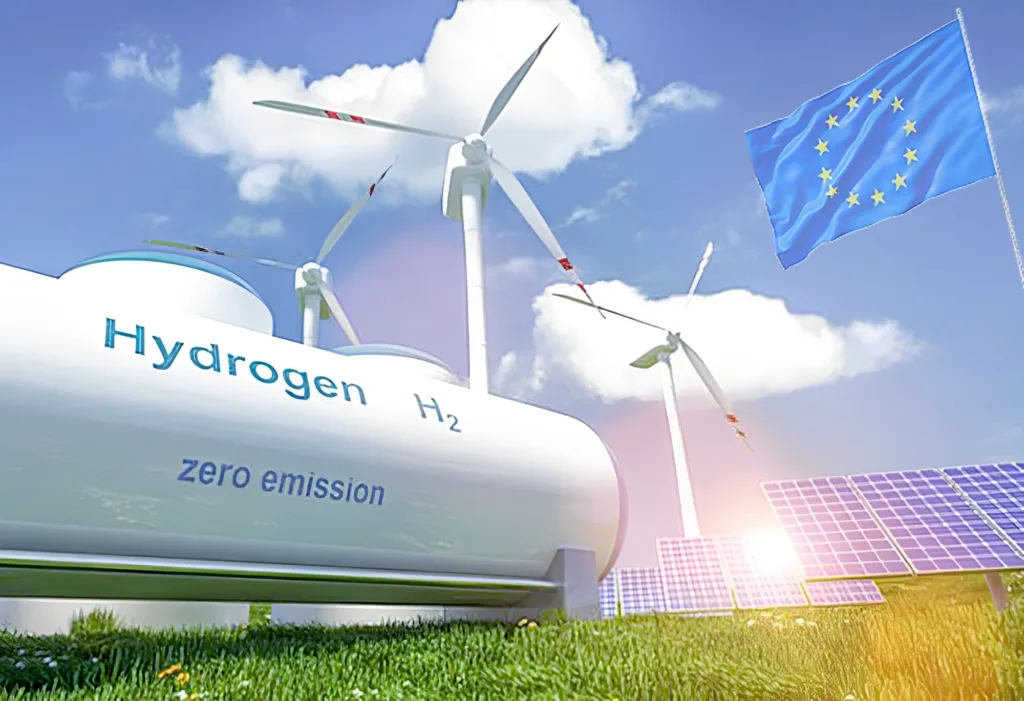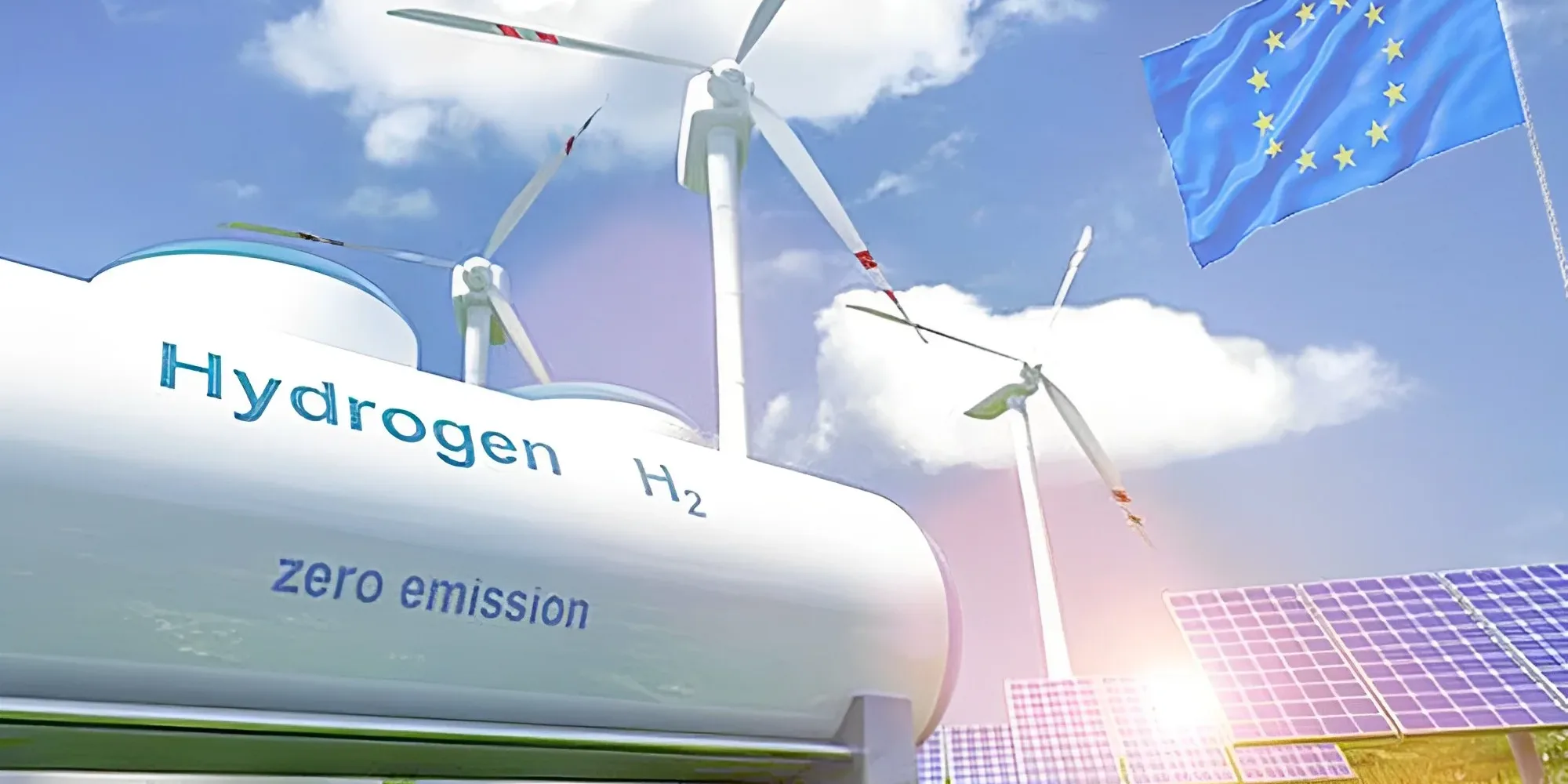Hydrogen’s crucial role in Europe’s energy transition

Source : kpi.ua/en/hydrogen-strategy-about
Hydrogen, the simplest and most abundant element in the universe, is colorless in its pure form. However, when it comes to hydrogen production, a vibrant spectrum of colors emerges, representing the diversity of processes by which hydrogen can be harnessed as a sustainable fuel source.
This “hydrogen rainbow” is more than a mere colorful categorization; it’s a roadmap for understanding the environmental and economic impacts of hydrogen as part of our global energy transition. Forward Europe recognizes hydrogen as a key to not only combating climate change but also in strengthening Europe’s energy independence.
Green Hydrogen: The Clean Front-Runner
Green hydrogen represents the top of eco-friendly fuel production. Using electrolysis—an energy-intensive process where water is split into oxygen and hydrogen—green hydrogen requires a substantial electrical input. The “green” qualifier denotes that all this electricity is sourced from renewable energies such as wind, solar, or hydroelectric power. This method emits no greenhouse gases, positioning green hydrogen as a cornerstone of a potential zero-carbon future.
The versatility of green hydrogen is immense. It can be generated on-site where it’s needed or at power-generation sites, minimizing the cost and energy associated with transportation. It can also be produced during off-peak energy times, acting as a storage medium to balance electricity grids.
But green hydrogen is not without its economic challenges. The capital costs for electrolyzers and the currently higher prices for renewable energy (compared to fossil fuels) can make it expensive. Its production is also water-intensive, which could pose challenges in arid regions. Moreover, the efficiency of electrolysis is still a subject of ongoing improvement, and the infrastructural shift to hydrogen use in industries and transportation is significant.
Blue Hydrogen: Bridging the Gap
Blue hydrogen is positioned as a pragmatic bridge between fossil fuels and the future green economy. It is primarily produced from natural gas through processes like steam methane reforming or autothermal reforming, with carbon emissions being captured and stored or utilized elsewhere. This process benefits from the mature natural gas infrastructure and the economic efficiency of large-scale operations.
However, the environmental footprint of blue hydrogen is contingent on the effectiveness of carbon capture and storage (CCS) technologies. While it reduces CO2 emissions compared to traditional methods, CCS does not eliminate them entirely. There’s also a financial consideration since the implementation of CCS inflates the cost of hydrogen production.
The promise of blue hydrogen lies in its potential to mitigate current CO2 emissions from the energy sector while leveraging existing investments in natural gas infrastructure. However, it is a temporary solution that relies on the finite resource of natural gas and is susceptible to the volatility of global gas markets.
Grey Hydrogen: The Present Polluter
Grey hydrogen is the most widely produced and consumed form of hydrogen today, with an established production process and infrastructure globally. The steam methane reforming process that underpins grey hydrogen production is efficient and well-understood but results in high CO2 emissions, casting a shadow over its environmental viability.
The economic advantage of grey hydrogen is clear: it benefits from scale and the established supply chain and market. But this advantage is increasingly being challenged by the rising social and regulatory costs of carbon emissions. As Europe moves towards carbon-neutral goals, the role of grey hydrogen may diminish, supplanted by greener alternatives.
Yellow Hydrogen: Harnessing the Sun
Yellow hydrogen’s unique selling point is its direct link to solar power. By using photovoltaic cells to convert sunlight to electricity, this method of production is inherently clean and taps into the bountiful and ubiquitous nature of solar energy. Yellow hydrogen production aligns with global sunbelt regions’ strategies, providing an attractive option for countries with high solar irradiance.
However, the intermittency of solar power necessitates energy storage solutions, which hydrogen serves effectively. The integration of solar power with hydrogen production offers a promising avenue for energy storage, providing a buffer to accommodate the ebb and flow of solar availability. The capital costs of photovoltaic technology and the associated infrastructure for hydrogen production and storage are considerations that impact the economic viability of yellow hydrogen.
Join the Eurobeat!
The pulse of Europe, delivered daily.
Essential news, right in your inbox. Join the conversation today.
Subscribe now!
Turquoise Hydrogen: A Solid Twist
Turquoise hydrogen is at the frontier of hydrogen innovation, utilizing methane pyrolysis to produce hydrogen. This method generates solid carbon and hydrogen without direct CO2 emissions, offering a potentially transformative approach to using one of the world’s most abundant fossil fuels —natural gas— while mitigating its environmental impact.
The technology for methane pyrolysis is still in development, with ongoing research focused on improving its commercial viability and operational efficiency. The high temperatures required for pyrolysis present an energy challenge, and the market for the solid carbon by-product is still emerging. Nonetheless, turquoise hydrogen has the potential to reshape the natural gas industry by providing a cleaner way to meet the growing demand for hydrogen.
Brown/Black Hydrogen: The Carbon-Heavy Contenders
Brown and black hydrogen are produced from coal and lignite, respectively, through a process known as gasification. While coal gasification is an established technology with the advantage of utilizing abundant domestic coal resources, it is also the least environmentally friendly hydrogen production method. The process emits large quantities of CO2 and other pollutants, contradicting the global imperative to reduce greenhouse gas emissions.
Despite its current economic feasibility in coal-reliant countries, brown/black hydrogen faces mounting environmental, regulatory, and social challenges. Its future seems increasingly unsustainable in a world committed to combating climate change.
Pink and Red Hydrogen: The Nuclear Option
Pink hydrogen, produced via electrolysis using nuclear-derived electricity, offers a low-carbon alternative to fossil fuel-based hydrogen. The continuous output from nuclear plants makes them suitable for the baseline power supply necessary for the energy-intensive electrolysis process. However, the high costs associated with nuclear power, the long lead times for plant construction, and the public’s concern over radioactive waste and safety are significant barriers.
Red hydrogen, derived from the same electrolysis process but powered by Small Modular Reactors (SMRs), seeks to address some of these challenges. SMRs offer quicker build times, reduced financial investment, and a smaller geographic footprint, making them a more agile and potentially safer nuclear option.
Hydrogen’s Role in Transforming the Economy
Hydrogen fuel stands out for its minimal environmental impact, emitting only water vapor when used. This clean energy carrier is highly adaptable, finding applications in heavy transportation (such as buses, trucks, and even in planes and ships), and industrial processes (notably in steel and cement production) which are difficult to electrify.
Additionally, hydrogen serves as an efficient medium for energy storage, effectively balancing grid loads and storing surplus energy from renewable sources like wind and solar, thus enhancing the reliability and integration of renewable energy into the economy.
The decentralized nature of hydrogen production also contributes to European energy security and independence, reducing reliance on centralized power grids and fossil fuel imports. The burgeoning hydrogen industry is poised to drive economic growth and job creation, opening avenues for new technologies and industries.
Furthermore, hydrogen’s use, particularly in urban transportation, can markedly improve air quality by cutting down pollutants like nitrogen oxides (NOx), sulfur oxides (SOx), and particulate matter. Overall, hydrogen fuel’s broad spectrum of applications and environmental benefits make it a cornerstone in the transition to a more sustainable and greener economy.
Conclusion
Forward Europe’s commitment to hydrogen aligns with our goals for a united and sovereign Europe. By investing in hydrogen technologies, we aim to address energy independence, meet growing energy and hydrogen demand, and lead the fight against climate change. Our focus on red hydrogen, utilizing SMRs, is a strategic choice for Europe, offering greater energy autonomy and dual benefits of electricity and hydrogen production.
The best approach for Europe lies in a balanced mix of hydrogen production methods, predominantly green, blue, and red hydrogen. This blend allows us to leverage each method’s strengths while mitigating their limitations. Forward Europe’s investment in red hydrogen and SMRs is a step towards making hydrogen a viable long-term alternative to fossil fuels. Through innovative strategies and commitment, hydrogen can be the backbone of Europe’s sustainable and secure future.
Sources used for this article :
- https://www.youtube.com/watch?v=YQQFwyOYsQ4&list=PLvzGYAHif7ObgeGNK7TNtRTfLVSYj8fiX&index=12
- https://www.youtube.com/watch?v=oH1DKzG7W_o&list=PLvzGYAHif7ObgeGNK7TNtRTfLVSYj8fiX&index=18
- https://www.nationalgrid.com/stories/energy-explained/hydrogen-colour-spectrum
- https://www.iea.org/energy-system/low-emission-fuels/hydrogen
Join the Eurobeat!
The pulse of Europe, delivered daily.
Essential news, right in your inbox. Join the conversation today.
Subscribe now!



